Comprehensive Financial Budgeting, Analysis, and Performance Review
VerifiedAdded on 2021/02/20
|18
|4295
|33
Report
AI Summary
This comprehensive report delves into the intricacies of financial budgeting and control, offering a detailed analysis of various budgeting techniques. The report begins with the calculation of budgeted cost of sales and the preparation of a budgeted income statement, followed by the reconstruction of debtors control accounts for evaluating estimated balances. It further explores direct labour and sales budgets, along with an analysis of internal and external factors impacting budgets. The report includes a budgeted cash flow statement and a profit and loss statement, providing insights into the financial performance of a business. Part A focuses on the scope and nature of budgets, data interpretation, and the impact of various factors. Part B presents a cash budget, while Part C examines budget variance reports and cash balance predictions. The report concludes with an evaluation of the appropriateness of quarterly periods for cash budgeting and relevant recommendations.
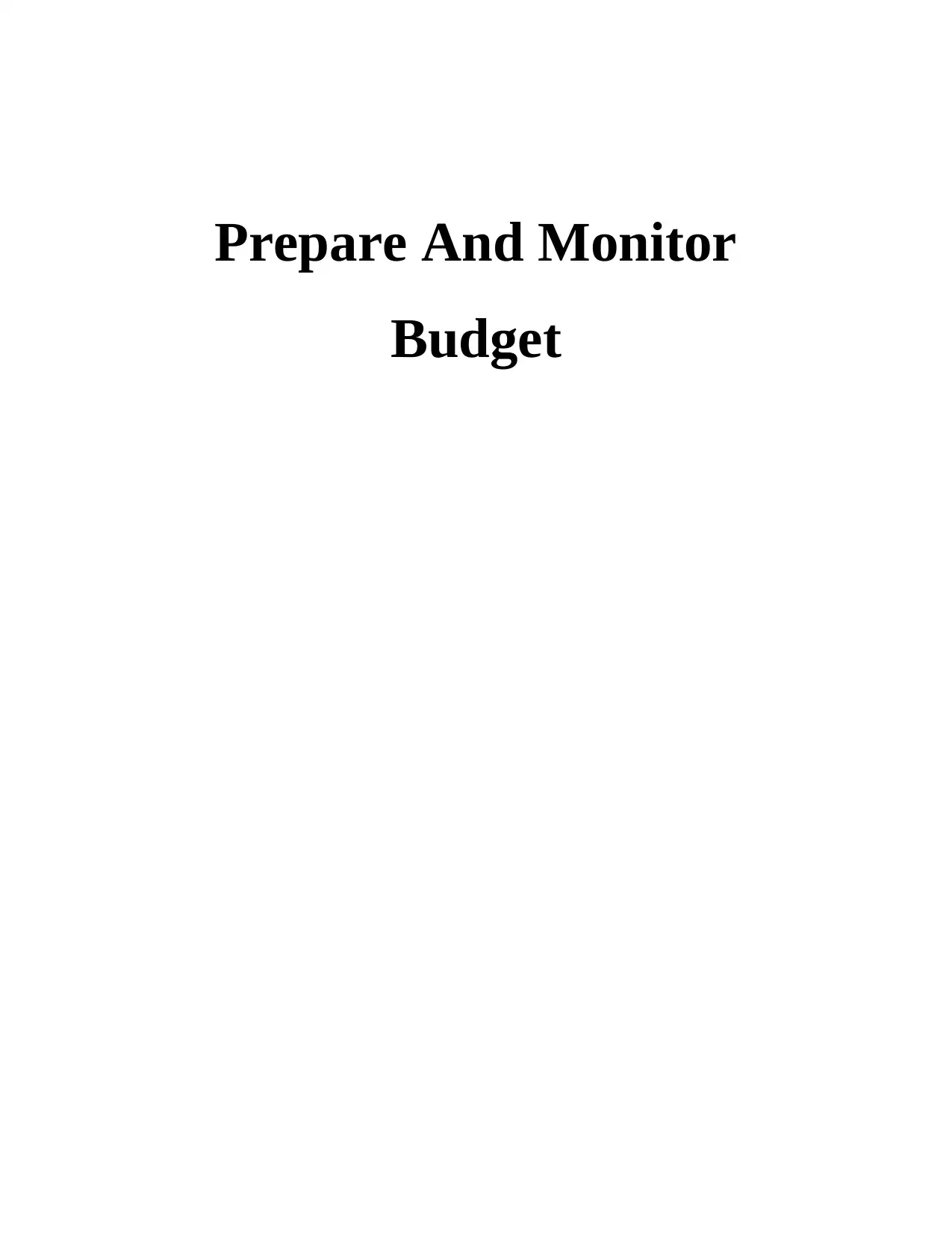
Prepare And Monitor
Budget
Budget
Paraphrase This Document
Need a fresh take? Get an instant paraphrase of this document with our AI Paraphraser
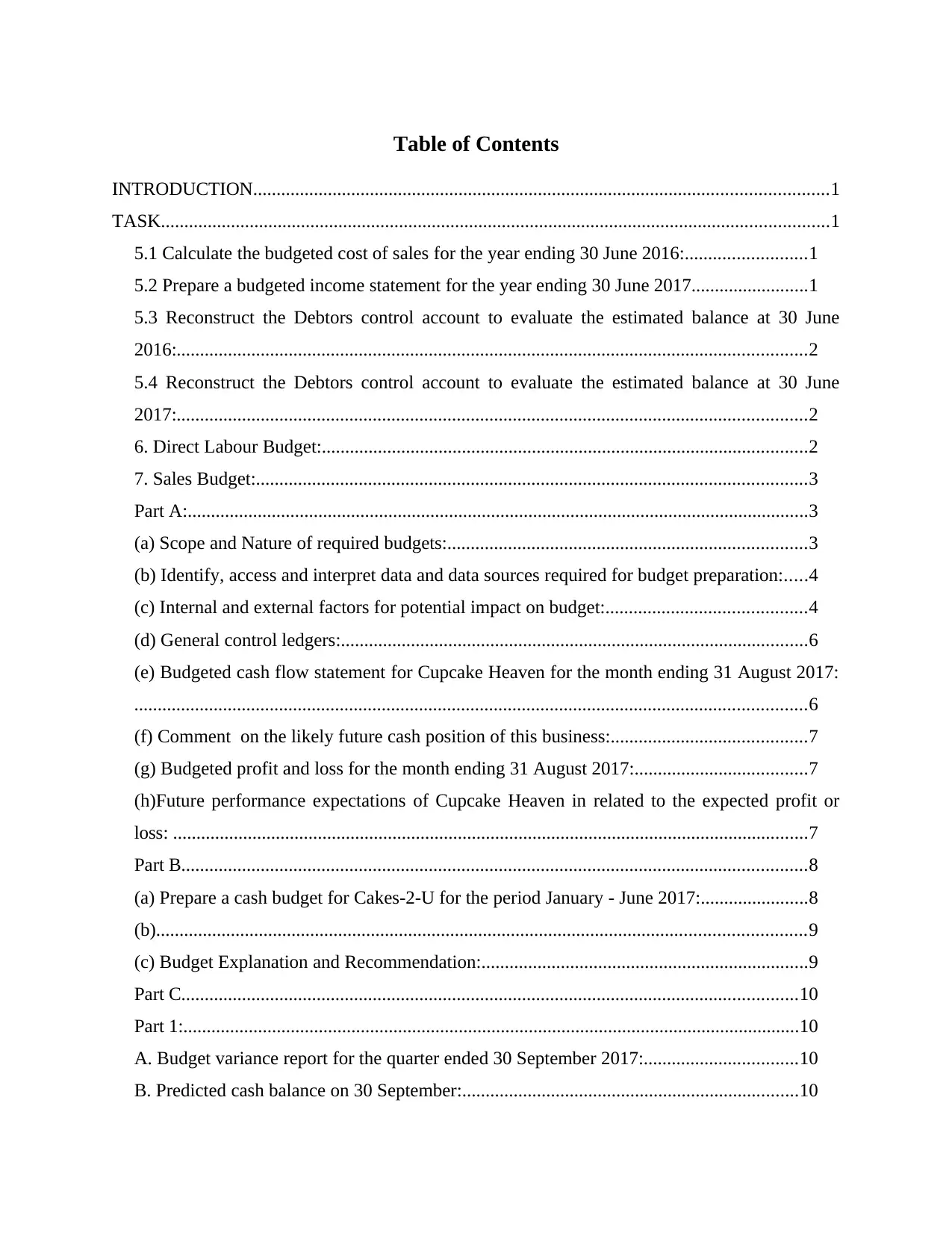
Table of Contents
INTRODUCTION...........................................................................................................................1
TASK...............................................................................................................................................1
5.1 Calculate the budgeted cost of sales for the year ending 30 June 2016:..........................1
5.2 Prepare a budgeted income statement for the year ending 30 June 2017.........................1
5.3 Reconstruct the Debtors control account to evaluate the estimated balance at 30 June
2016:.......................................................................................................................................2
5.4 Reconstruct the Debtors control account to evaluate the estimated balance at 30 June
2017:.......................................................................................................................................2
6. Direct Labour Budget:........................................................................................................2
7. Sales Budget:......................................................................................................................3
Part A:.....................................................................................................................................3
(a) Scope and Nature of required budgets:.............................................................................3
(b) Identify, access and interpret data and data sources required for budget preparation:.....4
(c) Internal and external factors for potential impact on budget:...........................................4
(d) General control ledgers:....................................................................................................6
(e) Budgeted cash flow statement for Cupcake Heaven for the month ending 31 August 2017:
................................................................................................................................................6
(f) Comment on the likely future cash position of this business:..........................................7
(g) Budgeted profit and loss for the month ending 31 August 2017:.....................................7
(h)Future performance expectations of Cupcake Heaven in related to the expected profit or
loss: ........................................................................................................................................7
Part B......................................................................................................................................8
(a) Prepare a cash budget for Cakes-2-U for the period January - June 2017:.......................8
(b)...........................................................................................................................................9
(c) Budget Explanation and Recommendation:......................................................................9
Part C....................................................................................................................................10
Part 1:....................................................................................................................................10
A. Budget variance report for the quarter ended 30 September 2017:.................................10
B. Predicted cash balance on 30 September:........................................................................10
INTRODUCTION...........................................................................................................................1
TASK...............................................................................................................................................1
5.1 Calculate the budgeted cost of sales for the year ending 30 June 2016:..........................1
5.2 Prepare a budgeted income statement for the year ending 30 June 2017.........................1
5.3 Reconstruct the Debtors control account to evaluate the estimated balance at 30 June
2016:.......................................................................................................................................2
5.4 Reconstruct the Debtors control account to evaluate the estimated balance at 30 June
2017:.......................................................................................................................................2
6. Direct Labour Budget:........................................................................................................2
7. Sales Budget:......................................................................................................................3
Part A:.....................................................................................................................................3
(a) Scope and Nature of required budgets:.............................................................................3
(b) Identify, access and interpret data and data sources required for budget preparation:.....4
(c) Internal and external factors for potential impact on budget:...........................................4
(d) General control ledgers:....................................................................................................6
(e) Budgeted cash flow statement for Cupcake Heaven for the month ending 31 August 2017:
................................................................................................................................................6
(f) Comment on the likely future cash position of this business:..........................................7
(g) Budgeted profit and loss for the month ending 31 August 2017:.....................................7
(h)Future performance expectations of Cupcake Heaven in related to the expected profit or
loss: ........................................................................................................................................7
Part B......................................................................................................................................8
(a) Prepare a cash budget for Cakes-2-U for the period January - June 2017:.......................8
(b)...........................................................................................................................................9
(c) Budget Explanation and Recommendation:......................................................................9
Part C....................................................................................................................................10
Part 1:....................................................................................................................................10
A. Budget variance report for the quarter ended 30 September 2017:.................................10
B. Predicted cash balance on 30 September:........................................................................10
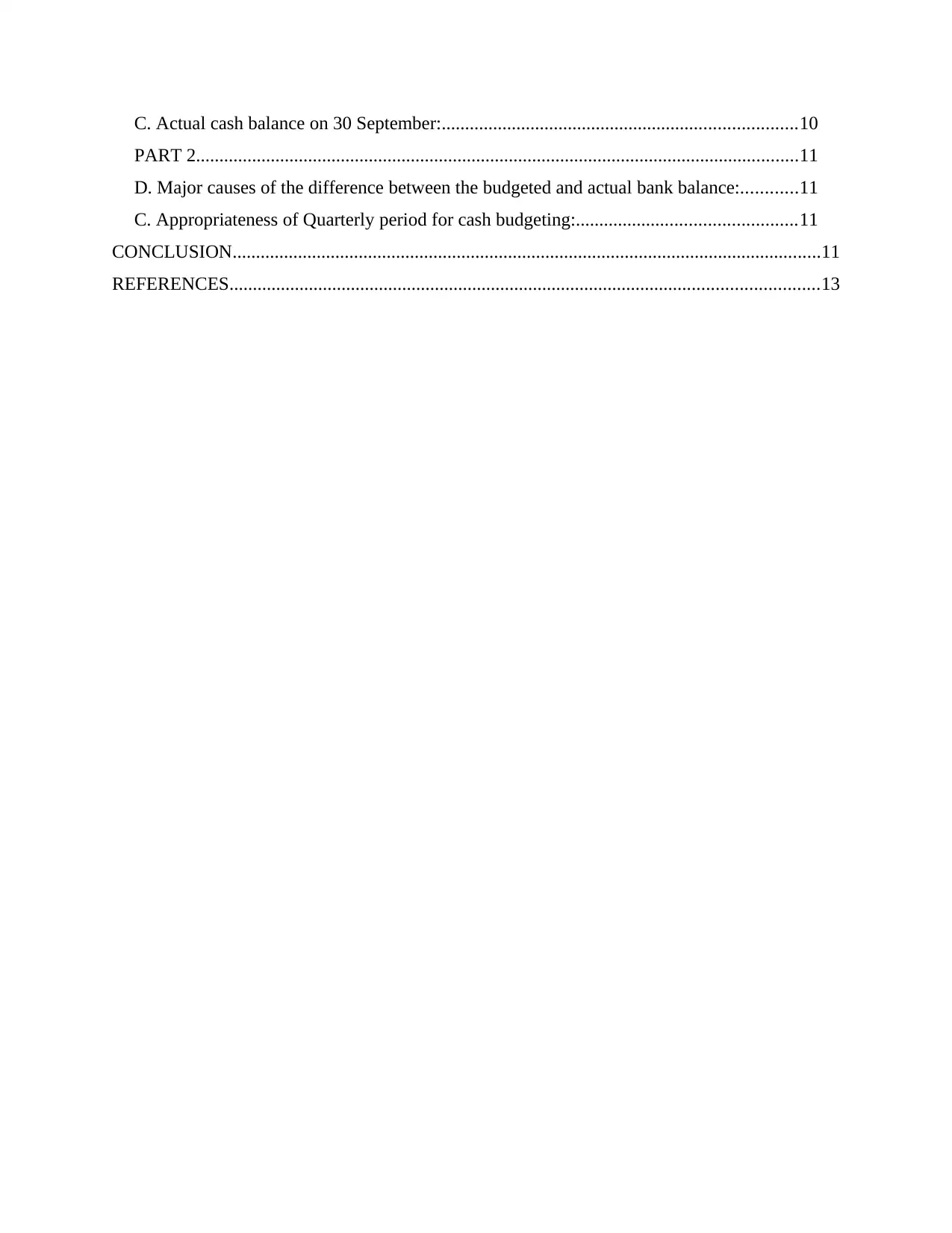
C. Actual cash balance on 30 September:............................................................................10
PART 2.................................................................................................................................11
D. Major causes of the difference between the budgeted and actual bank balance:............11
C. Appropriateness of Quarterly period for cash budgeting:...............................................11
CONCLUSION..............................................................................................................................11
REFERENCES..............................................................................................................................13
PART 2.................................................................................................................................11
D. Major causes of the difference between the budgeted and actual bank balance:............11
C. Appropriateness of Quarterly period for cash budgeting:...............................................11
CONCLUSION..............................................................................................................................11
REFERENCES..............................................................................................................................13
⊘ This is a preview!⊘
Do you want full access?
Subscribe today to unlock all pages.

Trusted by 1+ million students worldwide
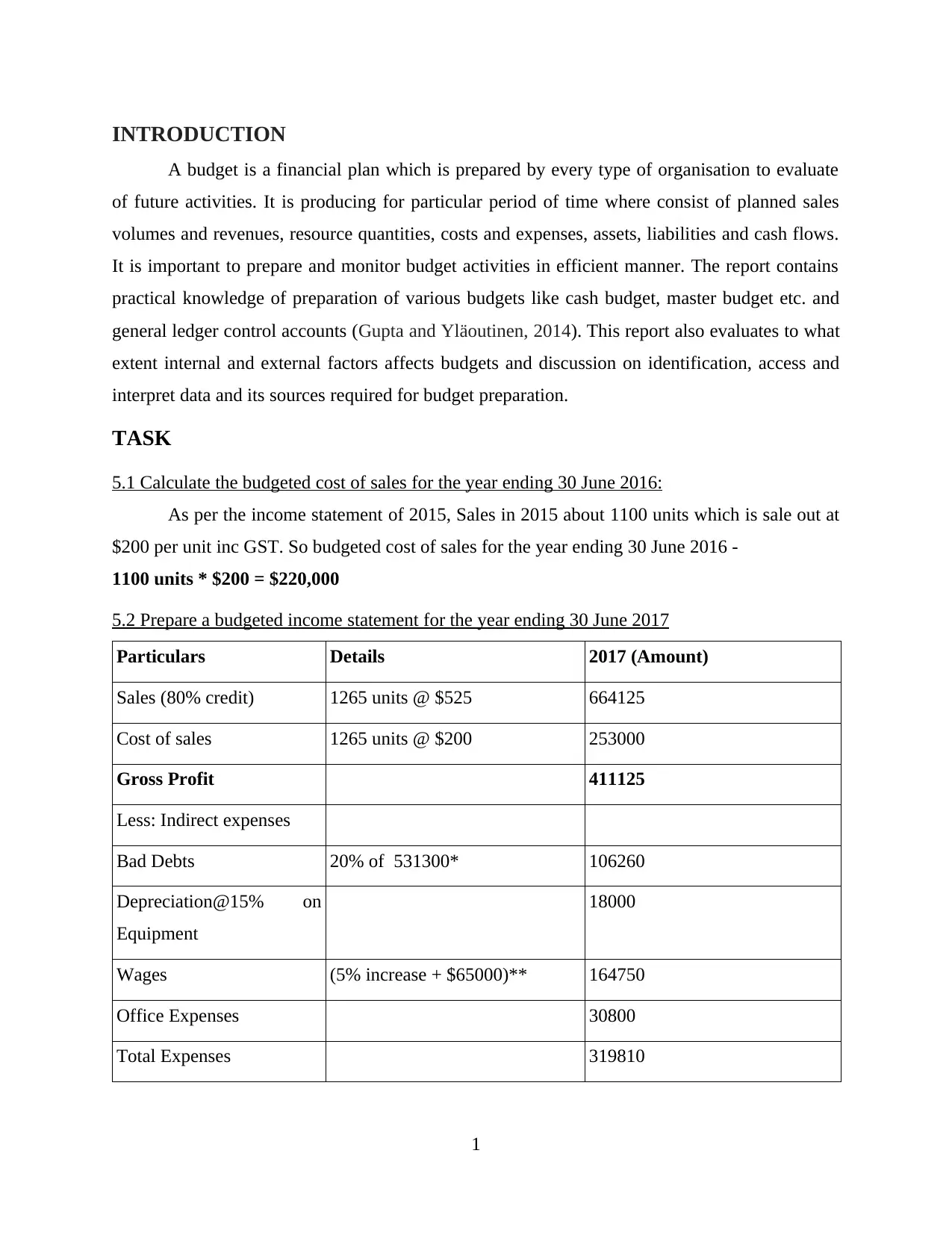
INTRODUCTION
A budget is a financial plan which is prepared by every type of organisation to evaluate
of future activities. It is producing for particular period of time where consist of planned sales
volumes and revenues, resource quantities, costs and expenses, assets, liabilities and cash flows.
It is important to prepare and monitor budget activities in efficient manner. The report contains
practical knowledge of preparation of various budgets like cash budget, master budget etc. and
general ledger control accounts (Gupta and Yläoutinen, 2014). This report also evaluates to what
extent internal and external factors affects budgets and discussion on identification, access and
interpret data and its sources required for budget preparation.
TASK
5.1 Calculate the budgeted cost of sales for the year ending 30 June 2016:
As per the income statement of 2015, Sales in 2015 about 1100 units which is sale out at
$200 per unit inc GST. So budgeted cost of sales for the year ending 30 June 2016 -
1100 units * $200 = $220,000
5.2 Prepare a budgeted income statement for the year ending 30 June 2017
Particulars Details 2017 (Amount)
Sales (80% credit) 1265 units @ $525 664125
Cost of sales 1265 units @ $200 253000
Gross Profit 411125
Less: Indirect expenses
Bad Debts 20% of 531300* 106260
Depreciation@15% on
Equipment
18000
Wages (5% increase + $65000)** 164750
Office Expenses 30800
Total Expenses 319810
1
A budget is a financial plan which is prepared by every type of organisation to evaluate
of future activities. It is producing for particular period of time where consist of planned sales
volumes and revenues, resource quantities, costs and expenses, assets, liabilities and cash flows.
It is important to prepare and monitor budget activities in efficient manner. The report contains
practical knowledge of preparation of various budgets like cash budget, master budget etc. and
general ledger control accounts (Gupta and Yläoutinen, 2014). This report also evaluates to what
extent internal and external factors affects budgets and discussion on identification, access and
interpret data and its sources required for budget preparation.
TASK
5.1 Calculate the budgeted cost of sales for the year ending 30 June 2016:
As per the income statement of 2015, Sales in 2015 about 1100 units which is sale out at
$200 per unit inc GST. So budgeted cost of sales for the year ending 30 June 2016 -
1100 units * $200 = $220,000
5.2 Prepare a budgeted income statement for the year ending 30 June 2017
Particulars Details 2017 (Amount)
Sales (80% credit) 1265 units @ $525 664125
Cost of sales 1265 units @ $200 253000
Gross Profit 411125
Less: Indirect expenses
Bad Debts 20% of 531300* 106260
Depreciation@15% on
Equipment
18000
Wages (5% increase + $65000)** 164750
Office Expenses 30800
Total Expenses 319810
1
Paraphrase This Document
Need a fresh take? Get an instant paraphrase of this document with our AI Paraphraser
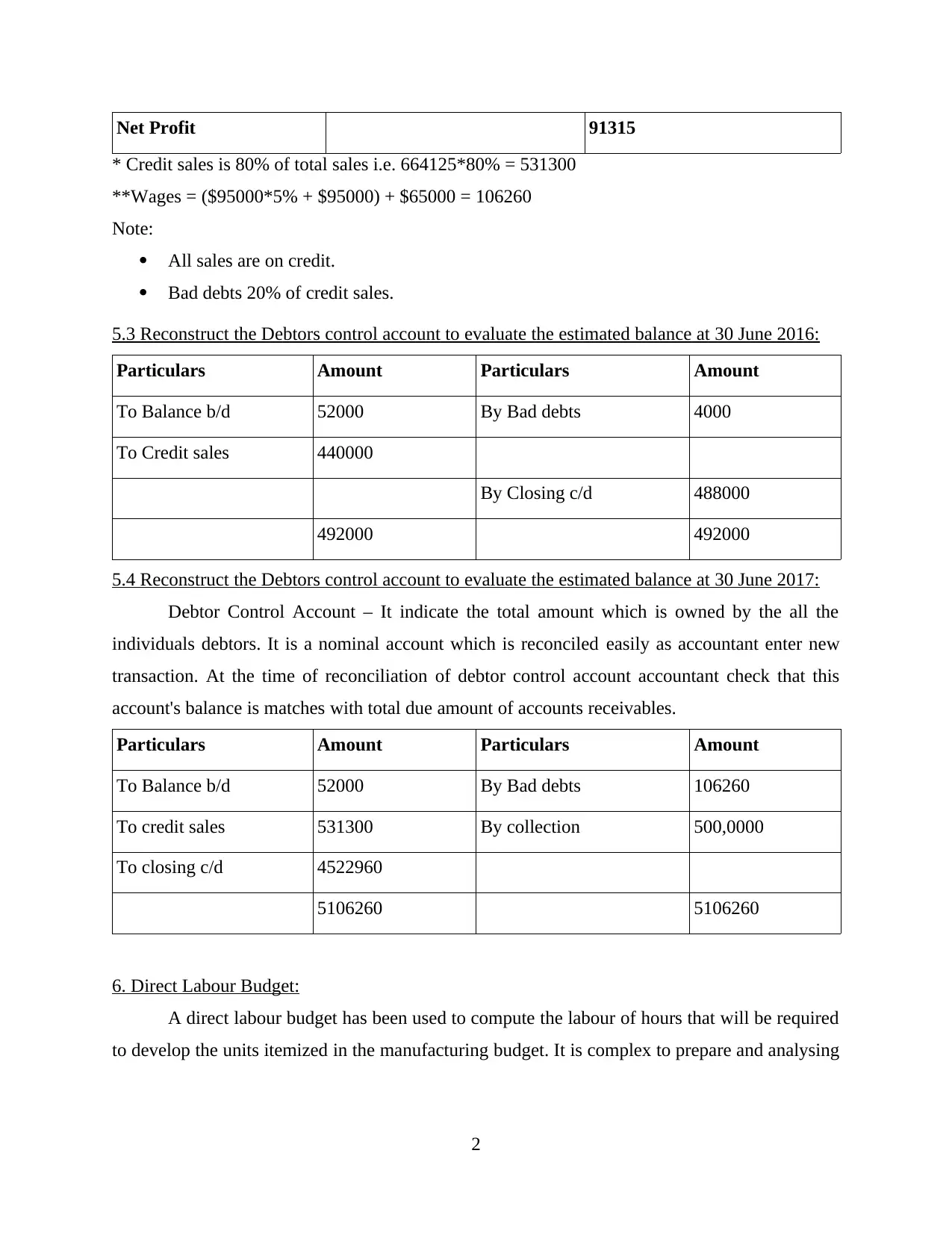
Net Profit 91315
* Credit sales is 80% of total sales i.e. 664125*80% = 531300
**Wages = ($95000*5% + $95000) + $65000 = 106260
Note:
All sales are on credit.
Bad debts 20% of credit sales.
5.3 Reconstruct the Debtors control account to evaluate the estimated balance at 30 June 2016:
Particulars Amount Particulars Amount
To Balance b/d 52000 By Bad debts 4000
To Credit sales 440000
By Closing c/d 488000
492000 492000
5.4 Reconstruct the Debtors control account to evaluate the estimated balance at 30 June 2017:
Debtor Control Account – It indicate the total amount which is owned by the all the
individuals debtors. It is a nominal account which is reconciled easily as accountant enter new
transaction. At the time of reconciliation of debtor control account accountant check that this
account's balance is matches with total due amount of accounts receivables.
Particulars Amount Particulars Amount
To Balance b/d 52000 By Bad debts 106260
To credit sales 531300 By collection 500,0000
To closing c/d 4522960
5106260 5106260
6. Direct Labour Budget:
A direct labour budget has been used to compute the labour of hours that will be required
to develop the units itemized in the manufacturing budget. It is complex to prepare and analysing
2
* Credit sales is 80% of total sales i.e. 664125*80% = 531300
**Wages = ($95000*5% + $95000) + $65000 = 106260
Note:
All sales are on credit.
Bad debts 20% of credit sales.
5.3 Reconstruct the Debtors control account to evaluate the estimated balance at 30 June 2016:
Particulars Amount Particulars Amount
To Balance b/d 52000 By Bad debts 4000
To Credit sales 440000
By Closing c/d 488000
492000 492000
5.4 Reconstruct the Debtors control account to evaluate the estimated balance at 30 June 2017:
Debtor Control Account – It indicate the total amount which is owned by the all the
individuals debtors. It is a nominal account which is reconciled easily as accountant enter new
transaction. At the time of reconciliation of debtor control account accountant check that this
account's balance is matches with total due amount of accounts receivables.
Particulars Amount Particulars Amount
To Balance b/d 52000 By Bad debts 106260
To credit sales 531300 By collection 500,0000
To closing c/d 4522960
5106260 5106260
6. Direct Labour Budget:
A direct labour budget has been used to compute the labour of hours that will be required
to develop the units itemized in the manufacturing budget. It is complex to prepare and analysing
2
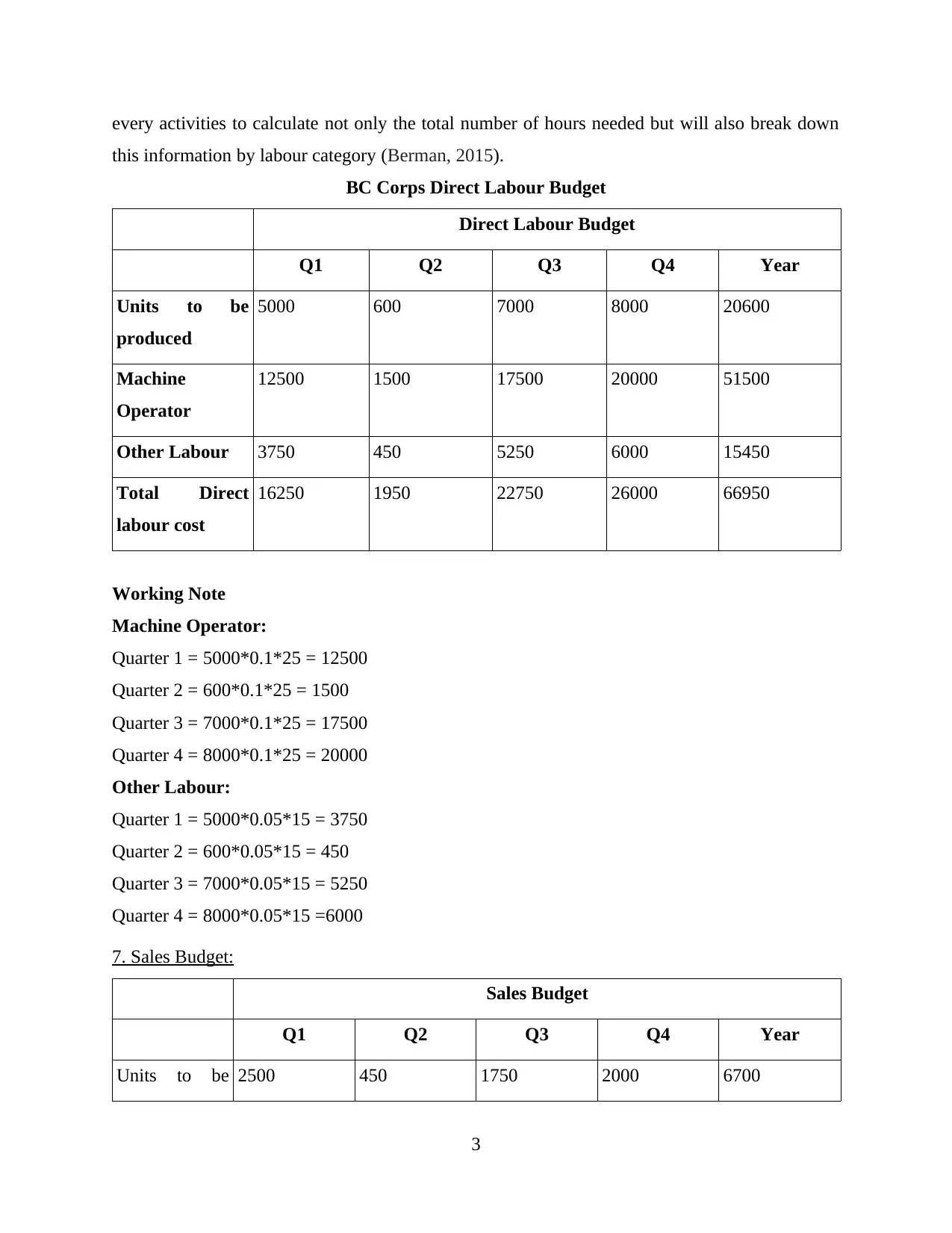
every activities to calculate not only the total number of hours needed but will also break down
this information by labour category (Berman, 2015).
BC Corps Direct Labour Budget
Direct Labour Budget
Q1 Q2 Q3 Q4 Year
Units to be
produced
5000 600 7000 8000 20600
Machine
Operator
12500 1500 17500 20000 51500
Other Labour 3750 450 5250 6000 15450
Total Direct
labour cost
16250 1950 22750 26000 66950
Working Note
Machine Operator:
Quarter 1 = 5000*0.1*25 = 12500
Quarter 2 = 600*0.1*25 = 1500
Quarter 3 = 7000*0.1*25 = 17500
Quarter 4 = 8000*0.1*25 = 20000
Other Labour:
Quarter 1 = 5000*0.05*15 = 3750
Quarter 2 = 600*0.05*15 = 450
Quarter 3 = 7000*0.05*15 = 5250
Quarter 4 = 8000*0.05*15 =6000
7. Sales Budget:
Sales Budget
Q1 Q2 Q3 Q4 Year
Units to be 2500 450 1750 2000 6700
3
this information by labour category (Berman, 2015).
BC Corps Direct Labour Budget
Direct Labour Budget
Q1 Q2 Q3 Q4 Year
Units to be
produced
5000 600 7000 8000 20600
Machine
Operator
12500 1500 17500 20000 51500
Other Labour 3750 450 5250 6000 15450
Total Direct
labour cost
16250 1950 22750 26000 66950
Working Note
Machine Operator:
Quarter 1 = 5000*0.1*25 = 12500
Quarter 2 = 600*0.1*25 = 1500
Quarter 3 = 7000*0.1*25 = 17500
Quarter 4 = 8000*0.1*25 = 20000
Other Labour:
Quarter 1 = 5000*0.05*15 = 3750
Quarter 2 = 600*0.05*15 = 450
Quarter 3 = 7000*0.05*15 = 5250
Quarter 4 = 8000*0.05*15 =6000
7. Sales Budget:
Sales Budget
Q1 Q2 Q3 Q4 Year
Units to be 2500 450 1750 2000 6700
3
⊘ This is a preview!⊘
Do you want full access?
Subscribe today to unlock all pages.

Trusted by 1+ million students worldwide
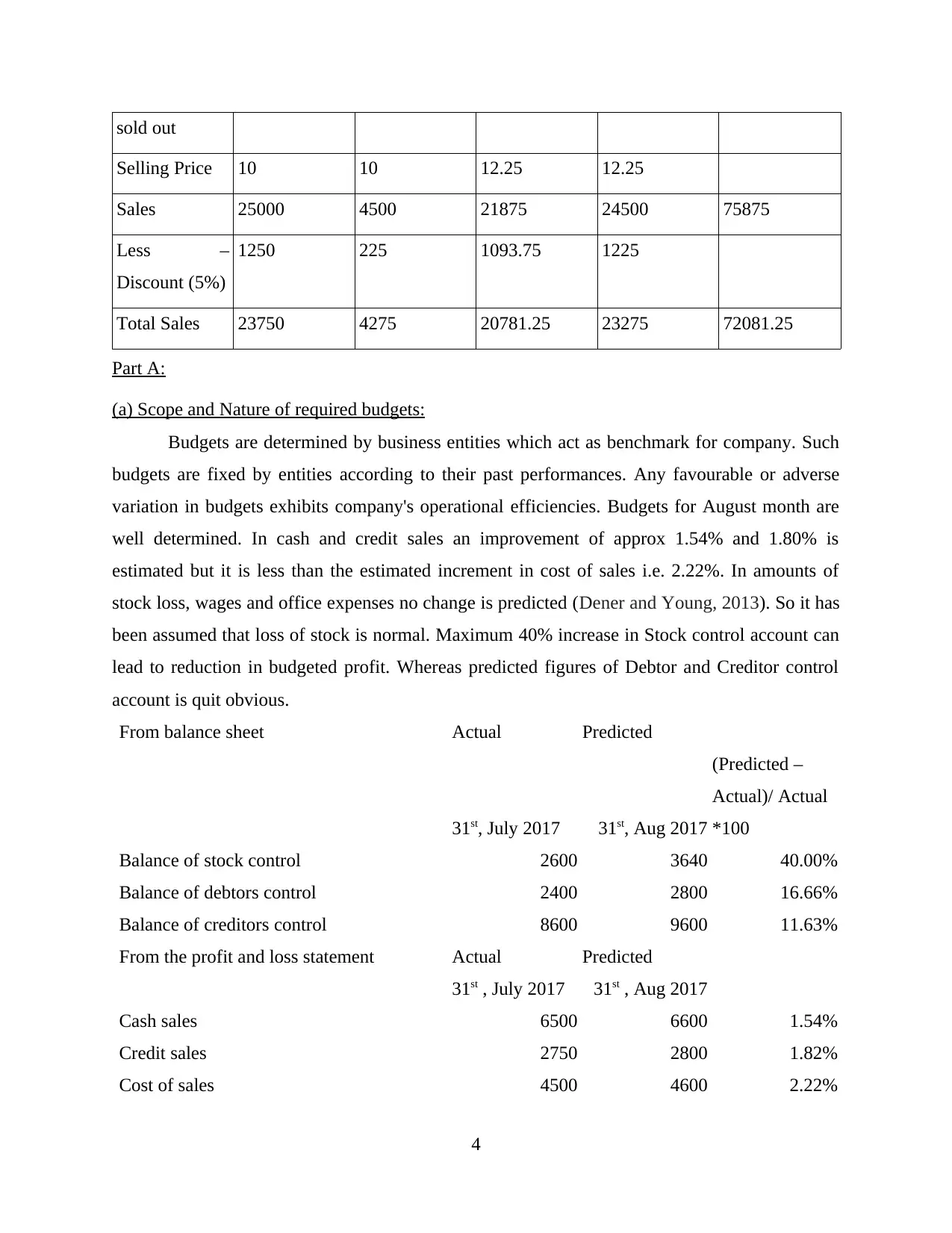
sold out
Selling Price 10 10 12.25 12.25
Sales 25000 4500 21875 24500 75875
Less –
Discount (5%)
1250 225 1093.75 1225
Total Sales 23750 4275 20781.25 23275 72081.25
Part A:
(a) Scope and Nature of required budgets:
Budgets are determined by business entities which act as benchmark for company. Such
budgets are fixed by entities according to their past performances. Any favourable or adverse
variation in budgets exhibits company's operational efficiencies. Budgets for August month are
well determined. In cash and credit sales an improvement of approx 1.54% and 1.80% is
estimated but it is less than the estimated increment in cost of sales i.e. 2.22%. In amounts of
stock loss, wages and office expenses no change is predicted (Dener and Young, 2013). So it has
been assumed that loss of stock is normal. Maximum 40% increase in Stock control account can
lead to reduction in budgeted profit. Whereas predicted figures of Debtor and Creditor control
account is quit obvious.
From balance sheet Actual Predicted
31st, July 2017 31st, Aug 2017
(Predicted –
Actual)/ Actual
*100
Balance of stock control 2600 3640 40.00%
Balance of debtors control 2400 2800 16.66%
Balance of creditors control 8600 9600 11.63%
From the profit and loss statement Actual Predicted
31st , July 2017 31st , Aug 2017
Cash sales 6500 6600 1.54%
Credit sales 2750 2800 1.82%
Cost of sales 4500 4600 2.22%
4
Selling Price 10 10 12.25 12.25
Sales 25000 4500 21875 24500 75875
Less –
Discount (5%)
1250 225 1093.75 1225
Total Sales 23750 4275 20781.25 23275 72081.25
Part A:
(a) Scope and Nature of required budgets:
Budgets are determined by business entities which act as benchmark for company. Such
budgets are fixed by entities according to their past performances. Any favourable or adverse
variation in budgets exhibits company's operational efficiencies. Budgets for August month are
well determined. In cash and credit sales an improvement of approx 1.54% and 1.80% is
estimated but it is less than the estimated increment in cost of sales i.e. 2.22%. In amounts of
stock loss, wages and office expenses no change is predicted (Dener and Young, 2013). So it has
been assumed that loss of stock is normal. Maximum 40% increase in Stock control account can
lead to reduction in budgeted profit. Whereas predicted figures of Debtor and Creditor control
account is quit obvious.
From balance sheet Actual Predicted
31st, July 2017 31st, Aug 2017
(Predicted –
Actual)/ Actual
*100
Balance of stock control 2600 3640 40.00%
Balance of debtors control 2400 2800 16.66%
Balance of creditors control 8600 9600 11.63%
From the profit and loss statement Actual Predicted
31st , July 2017 31st , Aug 2017
Cash sales 6500 6600 1.54%
Credit sales 2750 2800 1.82%
Cost of sales 4500 4600 2.22%
4
Paraphrase This Document
Need a fresh take? Get an instant paraphrase of this document with our AI Paraphraser
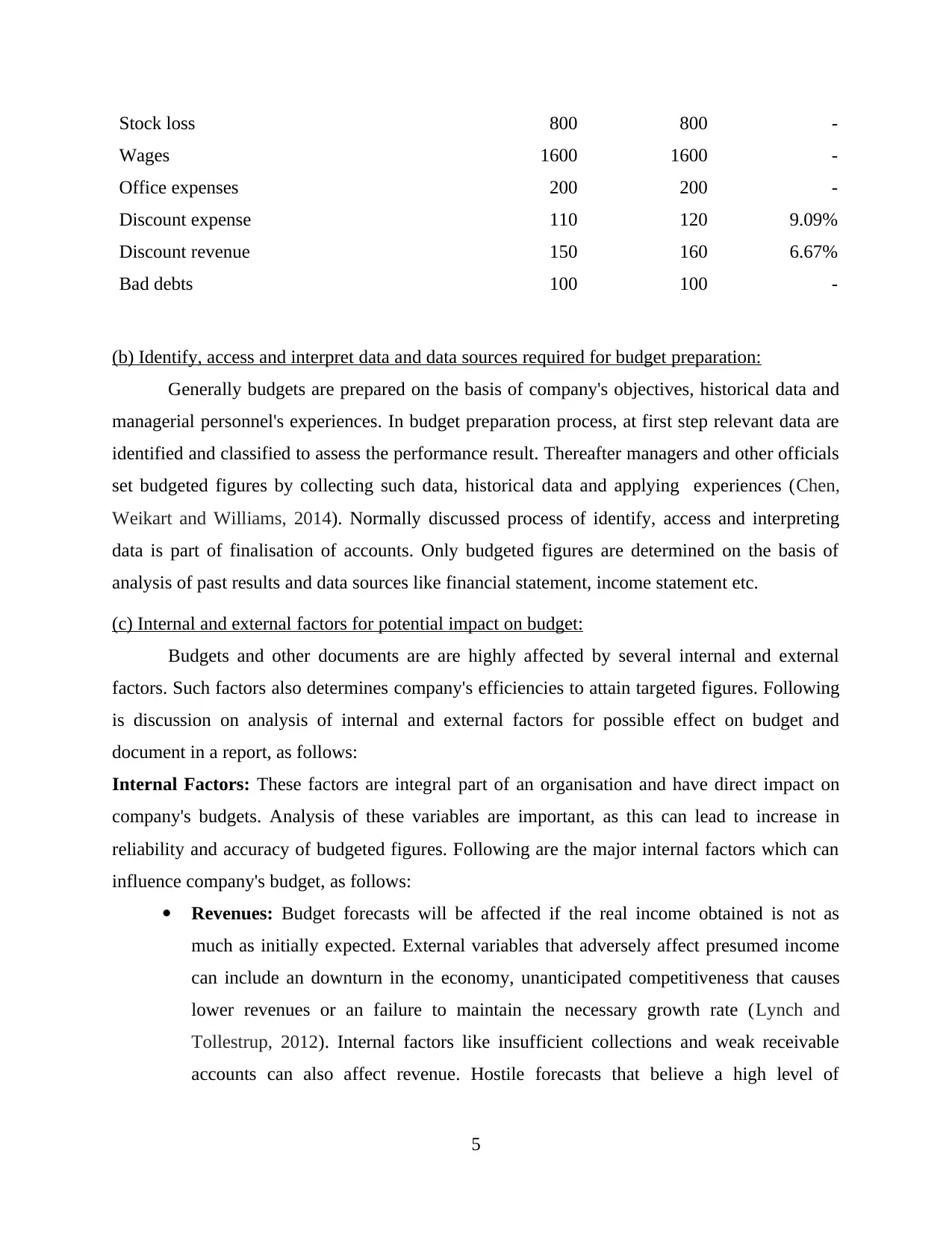
Stock loss 800 800 -
Wages 1600 1600 -
Office expenses 200 200 -
Discount expense 110 120 9.09%
Discount revenue 150 160 6.67%
Bad debts 100 100 -
(b) Identify, access and interpret data and data sources required for budget preparation:
Generally budgets are prepared on the basis of company's objectives, historical data and
managerial personnel's experiences. In budget preparation process, at first step relevant data are
identified and classified to assess the performance result. Thereafter managers and other officials
set budgeted figures by collecting such data, historical data and applying experiences (Chen,
Weikart and Williams, 2014). Normally discussed process of identify, access and interpreting
data is part of finalisation of accounts. Only budgeted figures are determined on the basis of
analysis of past results and data sources like financial statement, income statement etc.
(c) Internal and external factors for potential impact on budget:
Budgets and other documents are are highly affected by several internal and external
factors. Such factors also determines company's efficiencies to attain targeted figures. Following
is discussion on analysis of internal and external factors for possible effect on budget and
document in a report, as follows:
Internal Factors: These factors are integral part of an organisation and have direct impact on
company's budgets. Analysis of these variables are important, as this can lead to increase in
reliability and accuracy of budgeted figures. Following are the major internal factors which can
influence company's budget, as follows:
Revenues: Budget forecasts will be affected if the real income obtained is not as
much as initially expected. External variables that adversely affect presumed income
can include an downturn in the economy, unanticipated competitiveness that causes
lower revenues or an failure to maintain the necessary growth rate (Lynch and
Tollestrup, 2012). Internal factors like insufficient collections and weak receivable
accounts can also affect revenue. Hostile forecasts that believe a high level of
5
Wages 1600 1600 -
Office expenses 200 200 -
Discount expense 110 120 9.09%
Discount revenue 150 160 6.67%
Bad debts 100 100 -
(b) Identify, access and interpret data and data sources required for budget preparation:
Generally budgets are prepared on the basis of company's objectives, historical data and
managerial personnel's experiences. In budget preparation process, at first step relevant data are
identified and classified to assess the performance result. Thereafter managers and other officials
set budgeted figures by collecting such data, historical data and applying experiences (Chen,
Weikart and Williams, 2014). Normally discussed process of identify, access and interpreting
data is part of finalisation of accounts. Only budgeted figures are determined on the basis of
analysis of past results and data sources like financial statement, income statement etc.
(c) Internal and external factors for potential impact on budget:
Budgets and other documents are are highly affected by several internal and external
factors. Such factors also determines company's efficiencies to attain targeted figures. Following
is discussion on analysis of internal and external factors for possible effect on budget and
document in a report, as follows:
Internal Factors: These factors are integral part of an organisation and have direct impact on
company's budgets. Analysis of these variables are important, as this can lead to increase in
reliability and accuracy of budgeted figures. Following are the major internal factors which can
influence company's budget, as follows:
Revenues: Budget forecasts will be affected if the real income obtained is not as
much as initially expected. External variables that adversely affect presumed income
can include an downturn in the economy, unanticipated competitiveness that causes
lower revenues or an failure to maintain the necessary growth rate (Lynch and
Tollestrup, 2012). Internal factors like insufficient collections and weak receivable
accounts can also affect revenue. Hostile forecasts that believe a high level of
5
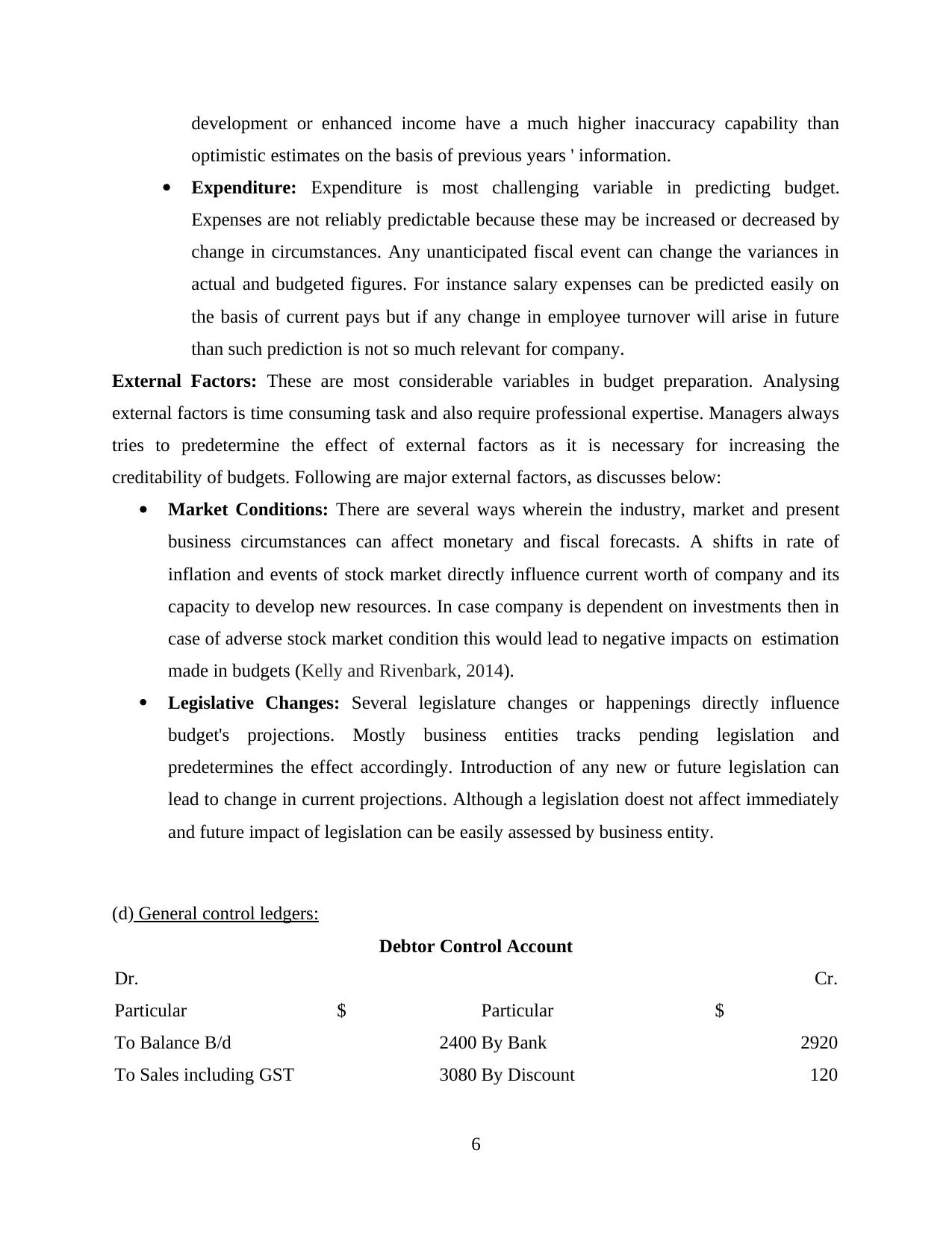
development or enhanced income have a much higher inaccuracy capability than
optimistic estimates on the basis of previous years ' information.
Expenditure: Expenditure is most challenging variable in predicting budget.
Expenses are not reliably predictable because these may be increased or decreased by
change in circumstances. Any unanticipated fiscal event can change the variances in
actual and budgeted figures. For instance salary expenses can be predicted easily on
the basis of current pays but if any change in employee turnover will arise in future
than such prediction is not so much relevant for company.
External Factors: These are most considerable variables in budget preparation. Analysing
external factors is time consuming task and also require professional expertise. Managers always
tries to predetermine the effect of external factors as it is necessary for increasing the
creditability of budgets. Following are major external factors, as discusses below:
Market Conditions: There are several ways wherein the industry, market and present
business circumstances can affect monetary and fiscal forecasts. A shifts in rate of
inflation and events of stock market directly influence current worth of company and its
capacity to develop new resources. In case company is dependent on investments then in
case of adverse stock market condition this would lead to negative impacts on estimation
made in budgets (Kelly and Rivenbark, 2014).
Legislative Changes: Several legislature changes or happenings directly influence
budget's projections. Mostly business entities tracks pending legislation and
predetermines the effect accordingly. Introduction of any new or future legislation can
lead to change in current projections. Although a legislation doest not affect immediately
and future impact of legislation can be easily assessed by business entity.
(d) General control ledgers:
Debtor Control Account
Dr. Cr.
Particular $ Particular $
To Balance B/d 2400 By Bank 2920
To Sales including GST 3080 By Discount 120
6
optimistic estimates on the basis of previous years ' information.
Expenditure: Expenditure is most challenging variable in predicting budget.
Expenses are not reliably predictable because these may be increased or decreased by
change in circumstances. Any unanticipated fiscal event can change the variances in
actual and budgeted figures. For instance salary expenses can be predicted easily on
the basis of current pays but if any change in employee turnover will arise in future
than such prediction is not so much relevant for company.
External Factors: These are most considerable variables in budget preparation. Analysing
external factors is time consuming task and also require professional expertise. Managers always
tries to predetermine the effect of external factors as it is necessary for increasing the
creditability of budgets. Following are major external factors, as discusses below:
Market Conditions: There are several ways wherein the industry, market and present
business circumstances can affect monetary and fiscal forecasts. A shifts in rate of
inflation and events of stock market directly influence current worth of company and its
capacity to develop new resources. In case company is dependent on investments then in
case of adverse stock market condition this would lead to negative impacts on estimation
made in budgets (Kelly and Rivenbark, 2014).
Legislative Changes: Several legislature changes or happenings directly influence
budget's projections. Mostly business entities tracks pending legislation and
predetermines the effect accordingly. Introduction of any new or future legislation can
lead to change in current projections. Although a legislation doest not affect immediately
and future impact of legislation can be easily assessed by business entity.
(d) General control ledgers:
Debtor Control Account
Dr. Cr.
Particular $ Particular $
To Balance B/d 2400 By Bank 2920
To Sales including GST 3080 By Discount 120
6
⊘ This is a preview!⊘
Do you want full access?
Subscribe today to unlock all pages.

Trusted by 1+ million students worldwide
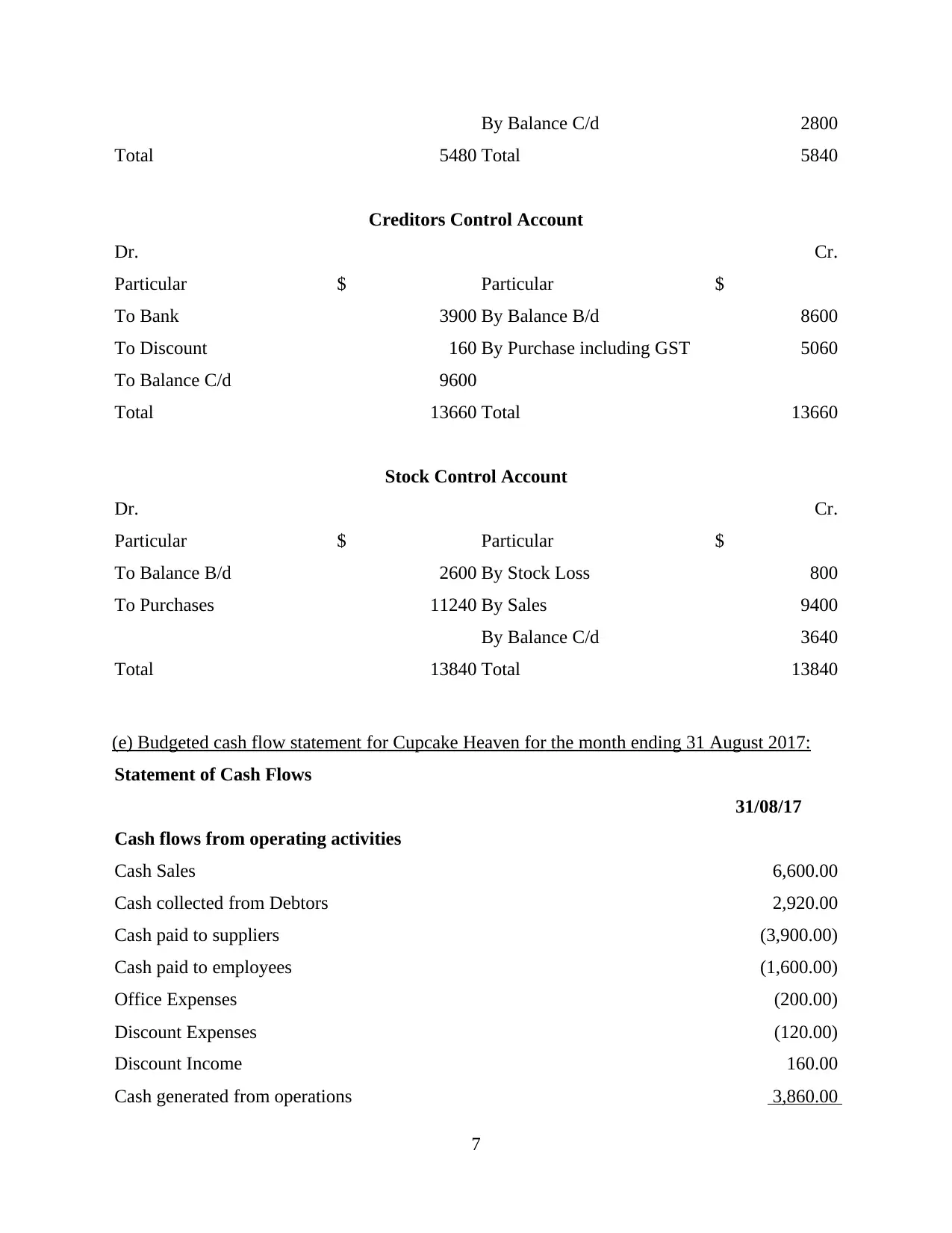
By Balance C/d 2800
Total 5480 Total 5840
Creditors Control Account
Dr. Cr.
Particular $ Particular $
To Bank 3900 By Balance B/d 8600
To Discount 160 By Purchase including GST 5060
To Balance C/d 9600
Total 13660 Total 13660
Stock Control Account
Dr. Cr.
Particular $ Particular $
To Balance B/d 2600 By Stock Loss 800
To Purchases 11240 By Sales 9400
By Balance C/d 3640
Total 13840 Total 13840
(e) Budgeted cash flow statement for Cupcake Heaven for the month ending 31 August 2017:
Statement of Cash Flows
31/08/17
Cash flows from operating activities
Cash Sales 6,600.00
Cash collected from Debtors 2,920.00
Cash paid to suppliers (3,900.00)
Cash paid to employees (1,600.00)
Office Expenses (200.00)
Discount Expenses (120.00)
Discount Income 160.00
Cash generated from operations 3,860.00
7
Total 5480 Total 5840
Creditors Control Account
Dr. Cr.
Particular $ Particular $
To Bank 3900 By Balance B/d 8600
To Discount 160 By Purchase including GST 5060
To Balance C/d 9600
Total 13660 Total 13660
Stock Control Account
Dr. Cr.
Particular $ Particular $
To Balance B/d 2600 By Stock Loss 800
To Purchases 11240 By Sales 9400
By Balance C/d 3640
Total 13840 Total 13840
(e) Budgeted cash flow statement for Cupcake Heaven for the month ending 31 August 2017:
Statement of Cash Flows
31/08/17
Cash flows from operating activities
Cash Sales 6,600.00
Cash collected from Debtors 2,920.00
Cash paid to suppliers (3,900.00)
Cash paid to employees (1,600.00)
Office Expenses (200.00)
Discount Expenses (120.00)
Discount Income 160.00
Cash generated from operations 3,860.00
7
Paraphrase This Document
Need a fresh take? Get an instant paraphrase of this document with our AI Paraphraser
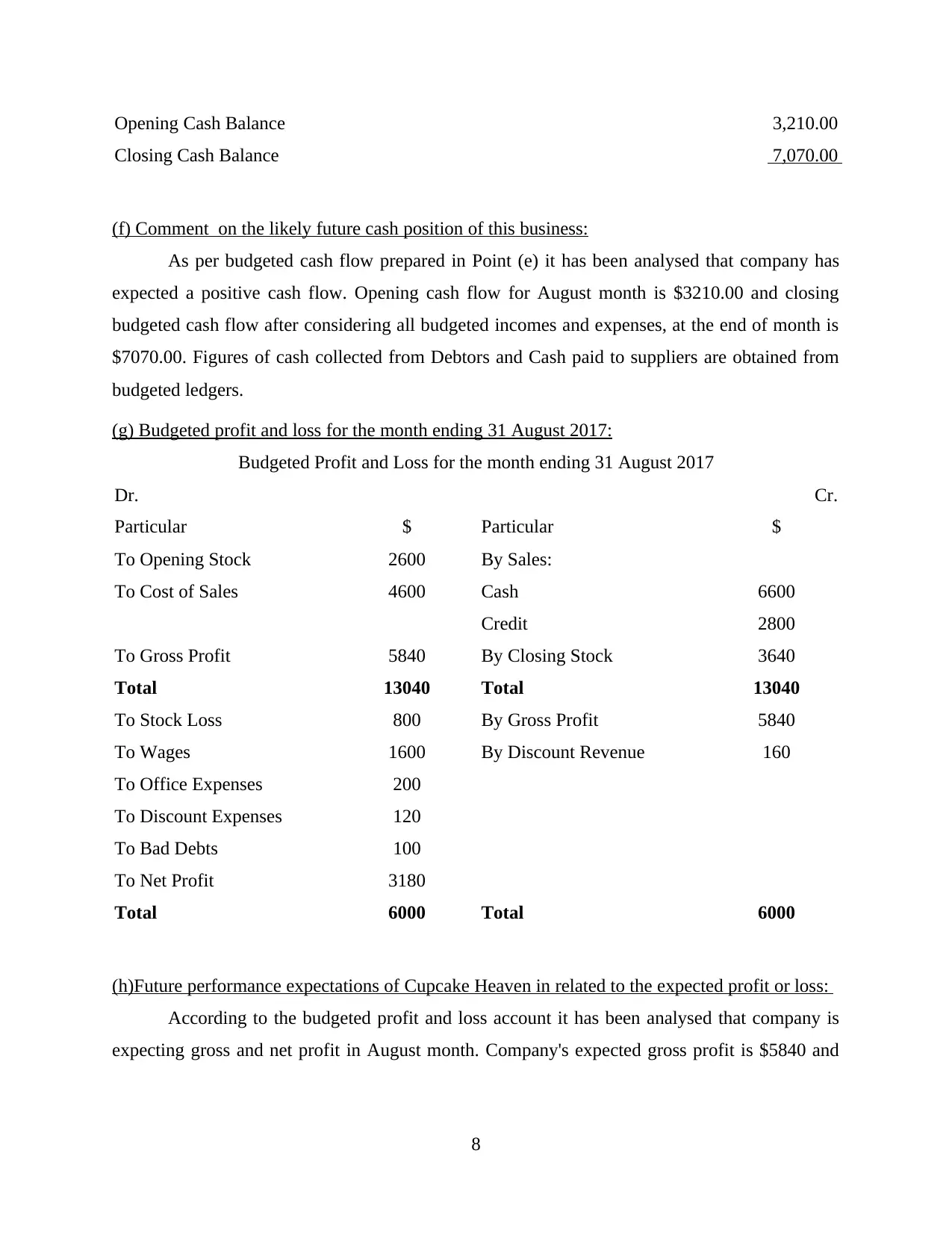
Opening Cash Balance 3,210.00
Closing Cash Balance 7,070.00
(f) Comment on the likely future cash position of this business:
As per budgeted cash flow prepared in Point (e) it has been analysed that company has
expected a positive cash flow. Opening cash flow for August month is $3210.00 and closing
budgeted cash flow after considering all budgeted incomes and expenses, at the end of month is
$7070.00. Figures of cash collected from Debtors and Cash paid to suppliers are obtained from
budgeted ledgers.
(g) Budgeted profit and loss for the month ending 31 August 2017:
Budgeted Profit and Loss for the month ending 31 August 2017
Dr. Cr.
Particular $ Particular $
To Opening Stock 2600 By Sales:
To Cost of Sales 4600 Cash 6600
Credit 2800
To Gross Profit 5840 By Closing Stock 3640
Total 13040 Total 13040
To Stock Loss 800 By Gross Profit 5840
To Wages 1600 By Discount Revenue 160
To Office Expenses 200
To Discount Expenses 120
To Bad Debts 100
To Net Profit 3180
Total 6000 Total 6000
(h)Future performance expectations of Cupcake Heaven in related to the expected profit or loss:
According to the budgeted profit and loss account it has been analysed that company is
expecting gross and net profit in August month. Company's expected gross profit is $5840 and
8
Closing Cash Balance 7,070.00
(f) Comment on the likely future cash position of this business:
As per budgeted cash flow prepared in Point (e) it has been analysed that company has
expected a positive cash flow. Opening cash flow for August month is $3210.00 and closing
budgeted cash flow after considering all budgeted incomes and expenses, at the end of month is
$7070.00. Figures of cash collected from Debtors and Cash paid to suppliers are obtained from
budgeted ledgers.
(g) Budgeted profit and loss for the month ending 31 August 2017:
Budgeted Profit and Loss for the month ending 31 August 2017
Dr. Cr.
Particular $ Particular $
To Opening Stock 2600 By Sales:
To Cost of Sales 4600 Cash 6600
Credit 2800
To Gross Profit 5840 By Closing Stock 3640
Total 13040 Total 13040
To Stock Loss 800 By Gross Profit 5840
To Wages 1600 By Discount Revenue 160
To Office Expenses 200
To Discount Expenses 120
To Bad Debts 100
To Net Profit 3180
Total 6000 Total 6000
(h)Future performance expectations of Cupcake Heaven in related to the expected profit or loss:
According to the budgeted profit and loss account it has been analysed that company is
expecting gross and net profit in August month. Company's expected gross profit is $5840 and
8
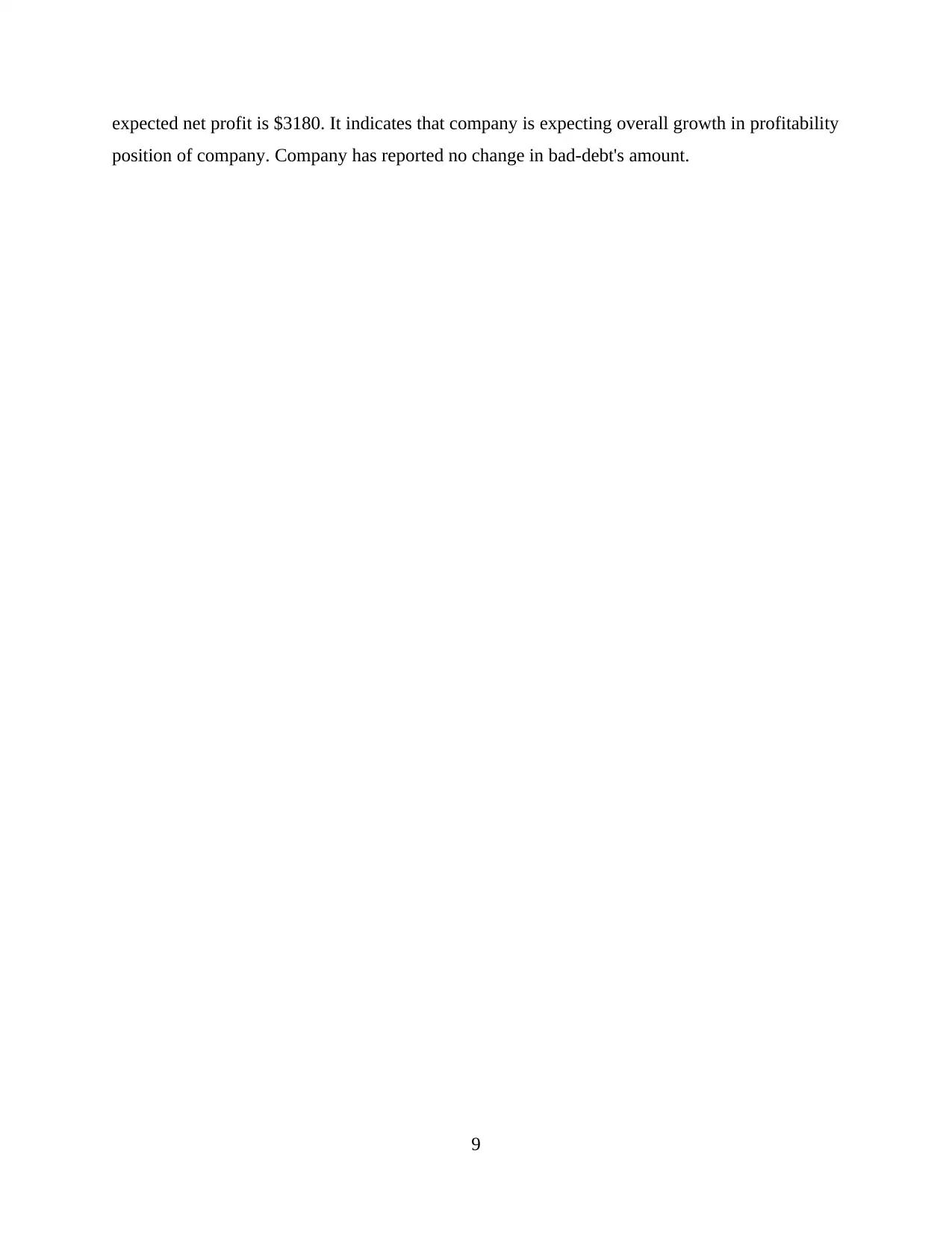
expected net profit is $3180. It indicates that company is expecting overall growth in profitability
position of company. Company has reported no change in bad-debt's amount.
9
position of company. Company has reported no change in bad-debt's amount.
9
⊘ This is a preview!⊘
Do you want full access?
Subscribe today to unlock all pages.

Trusted by 1+ million students worldwide
1 out of 18
Related Documents
Your All-in-One AI-Powered Toolkit for Academic Success.
+13062052269
info@desklib.com
Available 24*7 on WhatsApp / Email
![[object Object]](/_next/static/media/star-bottom.7253800d.svg)
Unlock your academic potential
Copyright © 2020–2025 A2Z Services. All Rights Reserved. Developed and managed by ZUCOL.





